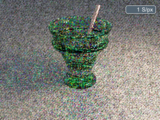LuxCoreRender
| LuxCoreRender
|
|
|---|---|

|
|
| Basic data
|
|
| developer | Terrence Vergauwen, Jean-Francois Romang, David Bucciarelli, Jean-Philippe Grimaldi, Ricardo Lipas Augusto, Asbjorn Heid and others |
| Publishing year | June 24, 2008 |
| Current version | 2.1 (January 4, 2019) |
| operating system | Windows , Linux , Mac OS X |
| programming language | C ++ |
| category | Computer graphics OpenCL |
| License | Apache License ( Free Software ) |
| luxcorerender.org | |
LuxCoreRender , formerly LuxRender, is a free rendering engine that can create physically correct images. There are exporters for Blender , Cinema 4D , Softimage or XSI and Maya . It is distributed as free software under version 2 of the Apache license .
overview
LuxCoreRender is a stand-alone 3D renderer and therefore does not offer the option of creating scenes in the program itself. The content to be rendered is created with other 3D graphics programs and then converted into the LuxRender format with one of the available exporters.
Emergence
LuxCoreRender is based on PBRT, a physics-based ray tracing program. Despite its great capabilities and structure, PBRT is geared towards academic use and therefore not easily accessible for digital art creation. Since PBRT is licensed under the GPL, it was possible to start your own project using the PBRT code as a starting point. With the blessings of the original authors, a small group of programmers took this step in September 2007. The new program was called LuxRender and was supposed to be written for artistic use. Since its inception, it has attracted the interest of various programmers around the world.
In the summer, the goals for a version 2.0 were decided: The previous API written in C should be replaced by a new C ++ and Python API, which was named LuxCore. In winter 2017 the new software version LuxCoreRender v2.0 was defined as LuxCore API based rendering software. The reprogramming also made it possible to change the license from GPL to the Apache license.
With the new LuxCoreRender API 2.0 for C ++ and Python, some improvements have been made, which, among other things, should lead to image processing that is up to ten times faster. LuxCore enables the use of OpenCL for the simultaneous use of several graphics processors and processor cores .
Functionality
Some of the features of LuxRender are:
- Biased and unbiased rendering: Users can choose between physical accuracy (unbiased) and rendering speed (biased).
- Support of the full light spectrum : Instead of the RGB color space, wavelengths are used for internal calculations.
- Hierarchical procedural and image-based texture system in which both types of textures can be combined in a variety of ways to create complex materials.
- Subdivision Surfaces and Displacement Mapping : Based on procedural or image textures, surfaces can be changed or refined.
- Volume scattering (subsurface scattering): enables the display of translucent materials, such as many plastics, organic materials and especially human skin.
- Shadowcatcher: an option with which a material can receive a shadow, but otherwise remains transparent and invisible. This method is used to enable a credible integration of rendered objects in photographs
- Network rendering: The rendering time can be reduced by using different computers in parallel.
- Motion and depth of field
- Elementary compositing functions. The so-called image pipeline is plugin-based and can therefore in principle be expanded using externally programmed effects.
- Three different camera types: perspective, orthographic , and a projection called environment camera , with which 360 ° spherical panoramas can be created.
- HDR output: Render results can be saved in various file formats, including .png, .tga and .exr.
- Light groups can be used to change the lighting using individual or combined light sources. This makes it possible to subsequently modify already rendered images as if they had been created under different lighting conditions. Light sources can be changed both in color and in the intensity with which they contribute to the overall result.
Web links
Individual evidence
- ↑ LuxRender authors. Retrieved October 15, 2009 .
- ↑ LuxCoreRender v2.1 released. Retrieved March 7, 2019 .
- ↑ Luxcore API. In: luxcorerender.org. LuxCoreRender project, accessed on May 10, 2018 .
- ↑ heterogeneus computing. In: luxcorerender.org. LuxCoreRender project, accessed on May 10, 2018 .
- ↑ LuxCoreRender User's Manual. In: luxcorerender.org. LuxCoreRender project, accessed May 10, 2018 .



